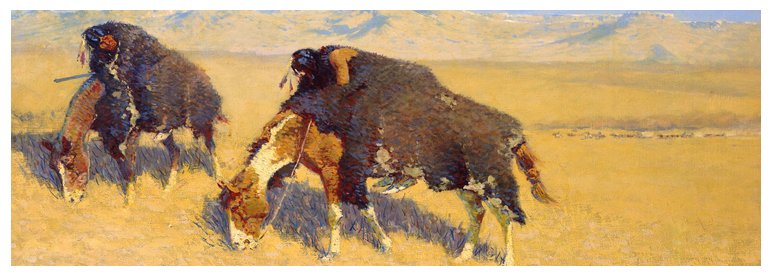
Frederic Sackrider Remington was an American painter, illustrator, sculptor, and writer who specialized in depictions of the Old American West, specifically concentrating on the last quarter of the 19th-century American West and images of cowboys, American Indians, and the U. S. Cavalry.
Remington was the most successful Western illustrator in the “Golden Age” of illustration at the end of the 19th Century and the beginning of the 20th Century, so much so that the other Western artists such as Charles Russell and Charles Schreyvogel were known during Remington’s life as members of the “School of Remington”. His style was naturalistic, sometimes impressionistic, and usually veered away from the ethnographic realism of earlier Western artists such as George Catlin. His focus was firmly on the people and animals of the West, with landscape usually of secondary importance, unlike the members and descendants of the Hudson River School, such as Frederic Edwin Church, Albert Bierstadt, and Thomas Moran, who glorified the vastness of the West and the dominance of nature over man. He took artistic liberties in his depictions of human action, and for the sake of his readers’ and publishers’ interest. Though always confident in his subject matter, Remington was less sure about his colors, and critics often harped on his palette, but his lack of confidence drove him to experiment and produce a great variety of effects, some very true to nature and some imagined.
His collaboration with Owen Wister on The Evolution of the Cowpuncher, published by Harper’s Monthly in September 1893, was the first statement of the mythical cowboy in American literature, spawning the entire genre of Western fiction, films, and theater that followed.[citation needed] Remington provided the concept of the project, its factual content, and its illustrations and Wister supplied the stories, sometimes altering Remington’s ideas. (Remington’s prototype cowboys were Mexican rancheros but Wister made the American cowboys descendants of Saxons—in truth, they were both partially right, as the first American cowboys were both the ranchers who tended the cattle and horses of the American Revolutionary army on Long Island and the Mexicans who ranched in the Arizona and California territories).
Remington’s The Right of the Road (1900), a black-and-white picture, depicts a bicyclist and a stagecoach both using a dusty road. He also painted The Old Stage-Coach of the Plains in 1901, a night scene in which the coach comes down a hill with illumination provided inside, possibly by a candle.
Remington was one of the first American artists to illustrate the true gait of the horse in motion (along with Thomas Eakins), as validated by the famous sequential photographs of Eadweard Muybridge. Previously, horses in full gallop were usually depicted with all four legs pointing out, like “hobby horses”. The galloping horse became Remington’s signature subject, copied and interpreted by many Western artists who followed him, adopting the correct anatomical motion. Though criticized by some for his use of photography, Remington often created depictions that slightly exaggerated natural motion to satisfy the eye. He wrote, “the artist must know more than the camera… (the horse must be) incorrectly drawn from the photographic standpoint (to achieve the desired effect).”
Also, noteworthy was Remington’s invention of “cowboy” sculpture. From his inaugural piece, The Broncho Buster (1895), he created an art form which is still very popular among collectors of Western art.
An early advocate of the photoengraving process over wood engraving for magazine reproduction of illustrative art, Remington became an accepted expert in reproduction methods, which helped gain him strong working relationships with editors and printers. Furthermore, Remington’s skill as a businessman was equal to his artistry, unlike many other artists who relied on their spouses or business agents or no one at all to run their financial affairs. He was an effective publicist and promoter of his art. He insisted that his originals be handled carefully and returned to him in pristine condition (without editor’s marks) so he could sell them. He carefully regulated his output to maximize his income and kept detailed notes about his works and his sales. In 1991 the PBS series American Masters filmed a documentary of Remington’s life called Frederic Remington: The Truth of Other Days produced and directed by Tom Neff.
Remington was portrayed by Nick Chinlund in the TNT miniseries Rough Riders (1997), which depicts the Spanish-American War, showing Remington’s time as a war correspondent and his partnership with William Randolph Hearst (portrayed by George Hamilton).
WorldFest-Houston International Film Festival’s main prize “The Remi Award” is named in Remington’s honor.
